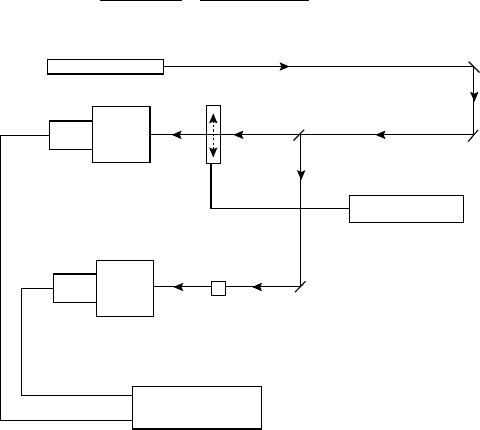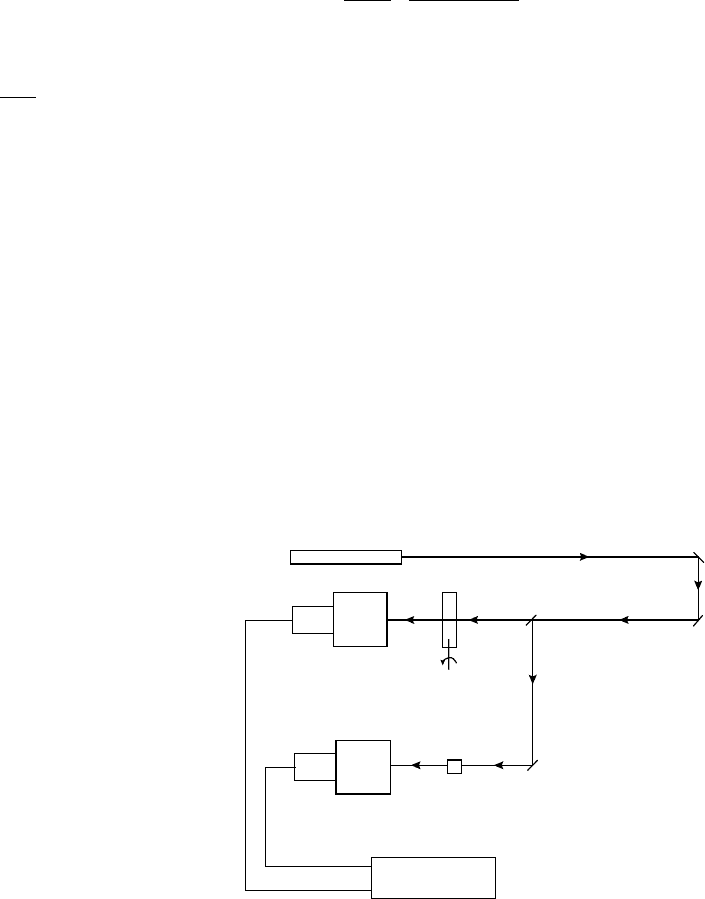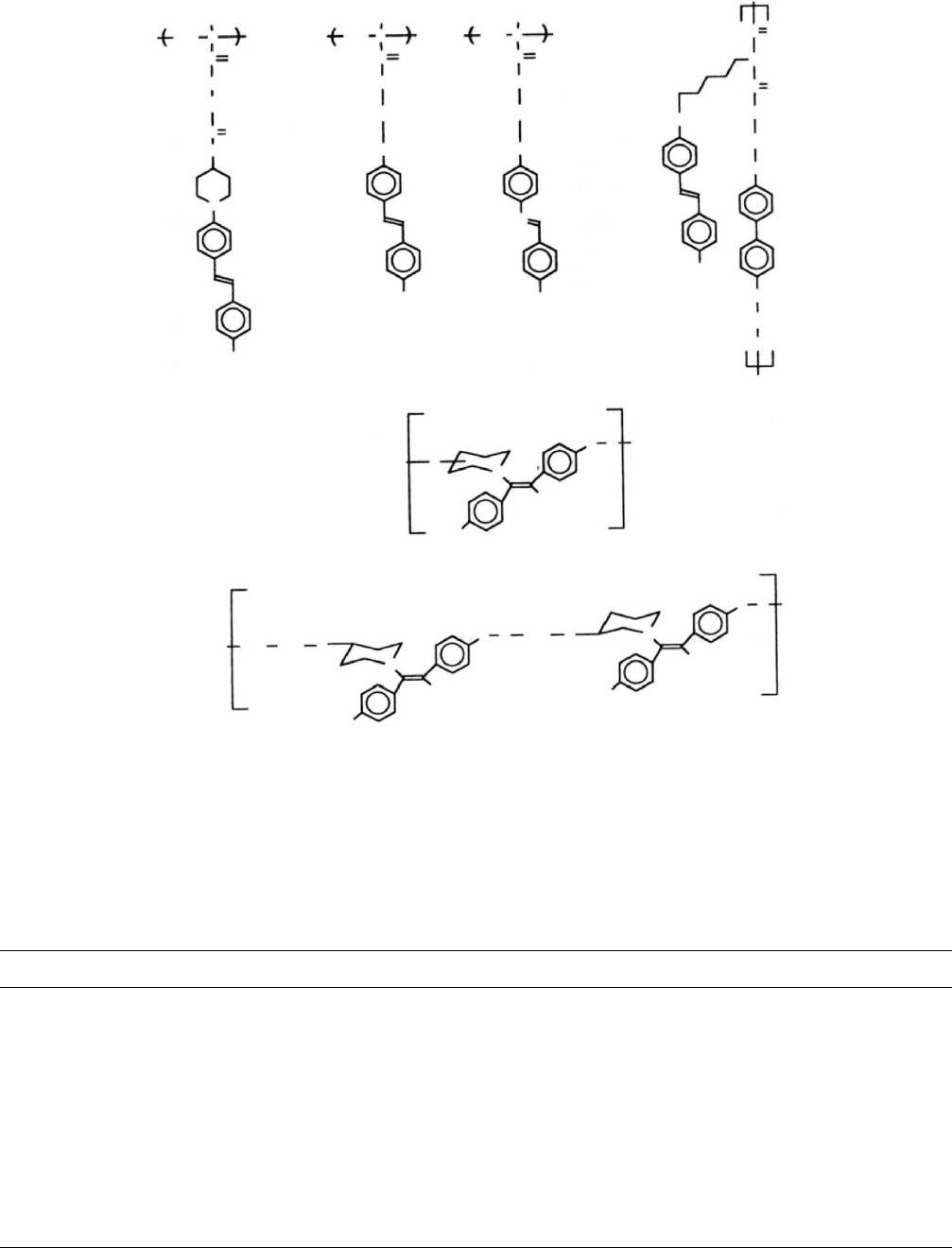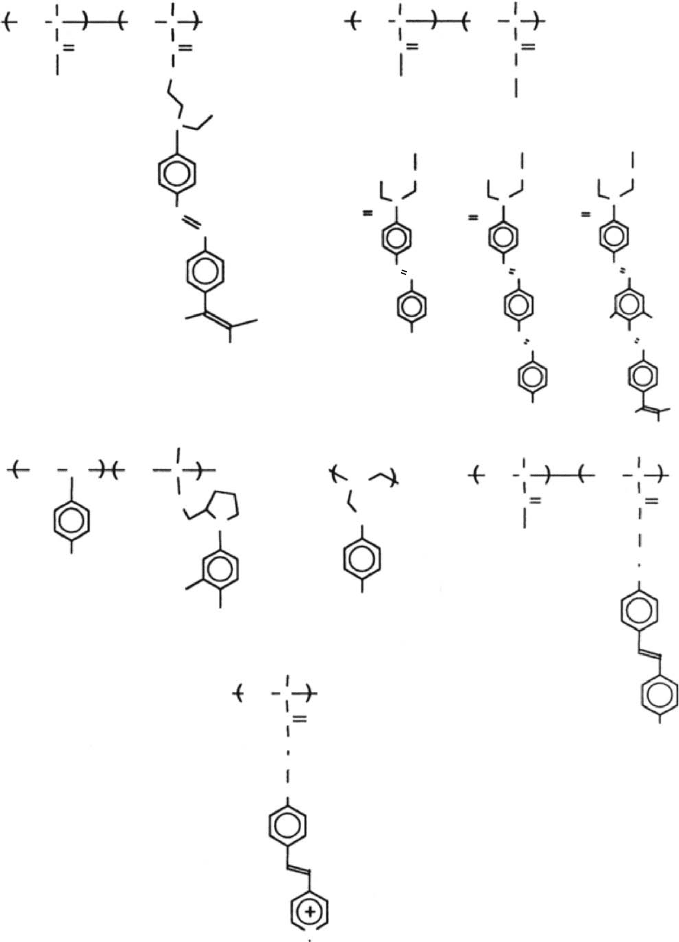Mark James E. (ed.). Physical Properties of Polymers Handbook
Подождите немного. Документ загружается.


voltage and the increasing poling temperature. Poling can
take place even at room temperature and below, if suffi-
ciently high electric field is applied. The PVF
2
b-phase
melts in temperature range 175–180 8C and no ferroelectric
phase transition below the melting temperature is observed.
The ferroelectric phase transition is observed in copolymers
of PVF
2
with poly(trifluoroethylene) (PF
3
E) or with poly
(tetrafluoroethylene) (PF
4
E). For example the study of the
51%mol PVF
2
– 49%mol PF
3
E copolymer shows the ferro-
electric-to-paraelectric first order phase transition at the
temperature 65 8C. The addition of PF
4
EorPF
3
E to PVF
2
increases the number of defects in the PVF
2
chains and
lowers the Curie temperature of the copolymer in compari-
son to the pure PVF
2
. The extrapolation of the plot of the
Curie temperature as a function of the PVF
2
content in the
copolymer to the pure PVF
2
gives the estimation of the
Curie point of PVF
2
at 190 8C. This temperature is above
the melting point temperature of PVF
2
and therefore the
Curie point for pure PVF
2
is not observed [18].
Ferroelectric properties (much weaker than PVF
2
) are
shown also by other polymers like poly(vinylchloride)
(PVC) or poly(vinylfluoride) (PVF). (See Table 48.3 for
comparison of piezoelectric and pyroelectric coefficients
of PVC and PVF with those for PVF
2
and for some ferro-
electric inorganic crystals).
In the mid-seventies it was shown that because of the
symmetry requirements, chiral smectic C liquid crystals
are ferroelectric [34]. Liquid crystals are formed by aniso-
tropic rod-like molecules. The most known liquid crystals
are nematics, with orientational ordering of molecular axis
of mesogenic molecules around the preferred direction, but
no spatial ordering. The smectic A liquid crystals have (in
addition to the orientational ordering) spatial alignment of
molecules in layers, with the preferred direction perpendicu-
lar to the plane of the layers. In the smectic C phase the
direction of orientational ordering is tilted relative to the
normal to the plane of the layers. Chiral molecules have no
center of symmetry, i.e., the mirror image of the molecule
differs from the molecule itself. If a chiral mesogenic mol-
ecule has permanent dipole moment, then the unit cell of the
smectic C phase has no center of symmetry and the material
should be ferroelectric. The first ferroelectric liquid crystal-
line polymer synthesized by Shibaev and Plate [35] is shown
below
(–CH
2
–C(CH
3
)–)
n
OC–O–(CH
2
)
10
– C – O – – OCO –
C
2
H
5
CH
3
– C – O – (CH
2
)
2
– CH
–
–
O
–
–
O
The molecule is a liquid crystalline polymer with chiral
smectic C phase forming parts attached as side chains. The
field required to switch the direction of polarization of the
polymer is very low (0:3 MVm
1
). There is a lot of interest
in liquid crystalline ferroelectric polymers, because of their
possible use for fast-switching electro-optical devices. More
information about ferroelectric liquid crystals can be found
in references [36,37].
Another group of ferroelectric polymers are odd nylons.
The most known is Nylon 11
O
k
(NHC(CH
2
)
10
)
n
In crystal phase Nylon 11 molecules are packed in sheets
with hydrogen bonds between oxygen atoms and NH groups
of neighboring chains, and dipole moments of Nylon 11
chains are aligned. The piezoelectric and pyroelectric coef-
ficients of Nylon 11 are smaller than those for PVF
2
(see
Table 48.4 for comparison).
A comprehensive bibliography for ferroelectric materials
(including polymers) has been recently published by
Toyoda [38].
48.5 PIEZOELECTRIC, PYROELECTRIC, AND
FERROELECTRIC PROPERTIES OF
BIOPOLYMERS
Piezoelectricity, pyroelectricity, and ferroelectricity is
hardly confined to synthetic polymers. Some biopolymers
also possess these properties, and scientists study them to
understand how nature exploits these properties. The earliest
studies of biopolymer piezoelectricity, for example, go back
to 1960s when Morris Shamos and Leroy Lavine (with
Michael Morris) studied bone piezoelectricity [39] and
later postulated piezoelectricity as a ‘‘fundamental prop-
erty’’ of tissues of biological origins [40]. In 1968, RNA
ferroelectricity was demonstrated by Stanford and Lorey
[41]. However, the scientific interest in these properties of
biological molecules was dwarfed by the interest in other
materials. In 1999 Sidney Lang [42] indicated that com-
pared to ‘‘thousands’’ of publications on piezoelectric, pyro-
electric, and ferroelectric materials, only less than 100 of
them were biologically related.
Piezoelectricity in biological molecules can be found both
in soft and hard tissues as shown in Table 48.5. In this table,
d
ij
represent piezoelectric coefficient components, which
792 / CHAPTER 48

are previously explained under piezoelectric polymers sec-
tion. Pyroelectric coefficients for some biological materials
are similarly given in Table 48.6. As explained under pyro-
electric polymers section, pyroelectric coefficients are re-
lated to piezoelectric coefficients. Compared to those of
PVF
2
films in Table 48.3, piezoelectric coefficients of bio-
polymers shown in Table 48.6 are very small and have
positive signs.
Piezoelectricity and pyroelectricity in biopolymers ori-
ginate from their building blocks: biopolymers are copoly-
mers with 20 different monomers. These monomers are
called amino acids and consist of a chiral carbon (except
glycine) surrounded by an amino group, hydrogen atom,
carboxyl group, and a side chain R as shown below.
C
H
R
NH
2
– – COOH
Different side chain groups determine the type of a given
amino acid. These side chains can be classified as neutral,
acidic, or basic; aliphatic or aromatic; hydrophobic or polar,
etc. As discussed previously, the piezoelectricity and pyro-
electricity requires restrictions on crystal symmetry (e.g., 20
crystallographic groups can be piezoelectric, and only
10 groups demonstrates pyroelectricity). The piezoelectric
response of amino acids to the high-frequency electric pulses
is shown in Table 48.7; the pyroelectric properties of amino
acids were also measured, but found not significant [44].
Ferroelectricity is a requirement for some biopolymers for
their biological function. Microtubules which hold the cell
structurally intact are a good example. These biostructures
consist of identical a and b tubulin proteins which have
permanent dipole moments. Since cells utilize microtubules
in cell division and to transport motor proteins, the
orientation of tubulin proteins becomes crucial for cell fit-
ness. This orientation may be controlled by electric fields
[46]. Microtubules alignment was reviewed by Cyr [47].
Another interesting biological example that shows ferro-
electric properties is voltage-dependent ion channels. These
channels are glycoproteins located in the cell membrane,
and they are found in either open or closed conformations.
In the open conformation, these proteins are ion conductors.
In the closed conformation, they become non-conducting,
yet they still retain their ferroelectricity, even showing
liquid crystalline properties [36,48].
There is a growing interest in studying the piezoelectri-
city, pyroelectricity, and ferroelectricity in biological sys-
tems to understand what roles they play in cellular
functions, and this interest is expected to increase in the
future.
REFERENCES
1. Kahn O. Molecular magnetism, New York: VCH publishers, 1993.
2. CJ O’Connor, editor, Research frontiers in magnetochemistry, Singa-
pore: World scientific, 1993.
3. D. Gatteschi et al., editors, Magnetic molecular materials, Dordrecht:
Kluwer, 1991.
4. Miller JS. Adv. Mater. 1992; 4:298.
5. McConnell HM. J. Chem. Phys. 1963;39:1910.
6. Miller JS, Epstein AJ, Rief WM. Chem.Rev. 1988; 88:201.
7. Mataga N. Theor. Chim. Acta 1968; 10:372.
8. Korshak YV, Medvedeva TV, Ovchinnikov AA. Nature 1987;326:370.
9. Ovchinnikov AA, Spector VN. Synth. Met. 1988;27:B615.
10. Torrance JB, Oostra S, Nazzal A. Synth. Met. 1987;19:709.
11. Iwamura H. Pure Appl.Chem. 1986;58:187.
12. Iwamura H. Adv. Phys. Org. Chem. 1990;26:179.
13. Palacio F, Ramos J, Castro C. Mol. Cryst. Liq. Cryst. Technol. Sect. A
1993;232:173.
14. Miller JS, Epstein AJ. Chem. Eng. News 1995;(October 2):30.
15. Kamachi M. J. Macromol. Sci. Part C Polym. Rev. 2002;42(4):541–561.
TABLE 48.5. Piezoelectric coefficients (in 10
12
m=V)in
biomaterials (taken from Lemanov [43]).
Material d
14
d
15
d
31
d
33
Bovine achiles tendon 2.7 1.4 0.09 0.07
Horse femur 0.2 0.04 0.003 0.003
Silk 1.1 0.25 0.02 0.023
TABLE 48.6. Pyroelectric coefficients (in 10
5
Cm
2
K)in
biomaterials (taken from Lemanov [43]).
Material Coefficient
Hoof tendon 0.00004
Insect thorax 0.35
Wheat 0.46
Plant leaves 0.015
TABLE 48.7. Piezoelectricity and symmetry groups of amino
acids [45] (L and D denote left-sided and right-sided
enantiomers, and DL is the equimolar mixture of
enantiomers).
Amino acid Piezoelectricity Symmetry
a-glycene þ C
2h
g-glycene þ C
3
L-alanine þ D
2
L-valine þ C
2
L-isoleucine C
2
,D
2
L-glutamic acid þ C
2
,D
2
L-cysteine C
4
,D
6
DL-alanine þ C
2v
DL-valine C
1
DL-serine C
2h
DL-aspartic acid C
2h
DL-lysine D
2
DL-tyrosine þ C
2v
DL-trptophan C
1
PROPERTIES OF SYNTHETIC AND BIOLOGICAL POLYMERS / 793
16. Wang TT, Herbert JM, Glass AM. editors, The application of ferro-
electric polymers, Glasgow: Blackie and Son, 1988.
17. Wong CP, editor, Polymers for electronic and photonic applications,
San Diego: Academic Press, 1993.
18. Kepler RG, Anderson RA. J. Appl. Phys. 1978;49:4490.
19. Kawai H. Jpn. J. Appl. Phys. 1969;8:975.
20. Schewe H, McAroy BR, editors. Ultrasonics Symposium Proceedings.
New York:IEEE, 1982. pp. 519.
21. Wang TT. J. Appl. Phys. 1979;50:6091.
22. Takase Y, Scheinbeim JI, Newman BA. J. Polym. Sci., Part B: Polym.
Phys. 1989;27:2347.
23. Ohigashi H. J. Appl. Phys. 1976;47:949.
24. GM Sessler, editor, Electrets, 2nd. ed. Berlin: Springer-Verlag, 1987.
25. Lang SB, Das-Gupta DK. Ferroelectrics Rev. 2000;2:217–354.
26. W.G. Caddy, Piezoelectricity, New York: McGraw-Hill, 1946.
27. Berlincourt DA, Curran DR, Jaffe H. Physical Acoustics. New York:
Academic Press, 1964. pp. 1.
28. Garn LE, Sharp EJ. IEEE Trans. PHP 1974;10:28.
29. Liu ST, Long D. Proc. IEEE 1978;66:14.
30. Litt MH, Hsu C, Basu P. 2005;No: 5 on Office of Naval Research
Contract No. N00014–75-c-0842
31. Phelan RJ Jr., Mahler RJ, Cook AR. Appl. Phys. Lett. 1971;19:337.
32. Day GW, Hamilton RL, Phelan RJ Jr., Mullen LO. Appl. Phys. Lett.
1974;24:456.
33. Lovinger AJ. Science 1983;220:1115.
34. Meyer RB, Liebert L, Strzelecki L, Keller P. J. Phys. Lett.
1975;36:L69.
35. Shibaev V, Plate N. Pure Appl. Chem. 1985;57:1589.
36. JW Goodby et al., Ferroelectric liquid crystals: principles, properties,
and applications, Philadelphia: Gordon and Breach, 1991.
37. Barny PL, Dubois JC, McArdle CB, editors. Side chain liquid crystal
polymers. Glaskow:Blackie and Son, 1989.
38. Toyoda K. Ferroelectrics 2003;282:57–216.
39. Shamos MH, Shamos MI, Lavine LS. Nature 1963;197:81.
40. Shamos MH, Lavine LS. Nature 1967;213:267–269.
41. Stanford AL, Lorey RA. Nature 1968;219:1250–1251.
42. Lang SB. 10th Inter. Symp. Electrets 1999.
43. Lemanov VV. Piezo-, Pyro-, and Ferroelectricity in biological mater-
ials. In:Galassi C, Dinescu M, Uchino K, Sayer M, editors. Piezoelec-
tric materials: advances in science, technology and applications.
Kluwer, 2000.
44. Lemanov VV, Popov SN, Pankova GA. Ferroelectrics 2003;285:
581–590.
45. Lemanov VV. Ferroelectrics 2000;238:211–218.
46. White RG, Hyde GJ, Overall RL. Protoplasma 1990;158:73–85.
47. Cyr RJ. Annu. Rev. Cell Biol. 1994;10:153–180.
48. Helluin O, Beyermann M, Leuchtag HR, Duclohier H. IEEE Trans.
Diec. Electr. Insul. 2001;8(4):637–643.
794 / CHAPTER 48

CHAPTER 49
Nonlinear Optical Properties of Polymers
W. M. K. P. Wijekoon, K.-S. Lee, and P. N. Prasad
The Institute for Lasers, Photonics and Biophotonics, Department of Chemistry,
The State University of New York at Buffalo, Buffalo, NY 14260-3000
49.1 Introduction ............................................................. 795
49.2 Measurements of b of Polymers ........................................... 796
49.3 Measurements of w
(2)
of Polymers ......................................... 797
49.4 b and w
(2)
Values of Polymers............................................. 798
49.5 Third-Order NLO Phenomena............................................. 804
49.6 Third-Harmonic Generation............................................... 805
49.7 Degenerate Four-Wave Mixing ............................................ 805
49.8 Optical Kerr Gate ........................................................ 806
49.9 Self-Focusing and Defocusing............................................. 806
49.10 Two-Photon Absorption . . ................................................ 807
49.11 g and w
(3)
Values of Polymers ............................................. 808
49.12 TPA Cross-Section Values of Organics and Polymers . ....................... 811
49.13 Variation in the
(2)
,
(3)
, and s
2
value .................................... 815
References . ............................................................. 818
49.1 INTRODUCTION
Nonlinear optical (NLO) properties of organic polymers
can be viewed as dielectric phenomena, and their origins can
conveniently be explained by considering a planar wave
propagation through a nonlinear dielectric medium [1–4].
In a dielectric medium the polarization P induced by the
incident field E can be written as a power series of the field
strength as follows:
P ¼ w
(1)
E þ w
(2)
.
.
.
EE þw
(3)
.
.
.
EEE þ, (49:1)
where P and E are vectors and w
(1)
, w
(2)
, and w
(3)
, which
relate P and E, are tensors. The linear polarizability tensor
w
(1)
is a second-rank tensor. w
(2)
is the hyperpolarizability
tensor and is a third-rank tensor and w
(3)
, the second hyper-
polarizability tensor, is a fourth-rank tensor. The first-order
term w
(1)
describes linear processes such as absorption,
refraction, and scattering while the higher-order terms w
(2)
and w
(3)
describe the second- and third-order NLO pro-
cesses, respectively.
In general, the polarization induced in an optical medium
by incident radiation can be written as [2,3]
P
I
(v) ¼ w
(1)
IJ
( v ) E
v
J
þ w
(2)
IJK
( v;v
1
,v
2
)
.
.
.
E
v
1
J
E
v
2
K
þ w
(3)
IJKL
( v;v
1
,v
2
v
3
)
.
.
.
E
v
1
J
E
v
2
K
E
v
3
L
þ: (49:2)
Obviously the larger the values of w
(2)
IJK
and w
(3)
IJKL
, the higher
the second- and third-order polarization created in the sam-
ple, respectively. In polymeric materials, the origin of the
optical nonlinearity can be traced to the molecular constitu-
ents, and therefore, one can identify polarization due to mo-
lecular units. Accordingly, the interaction of radiation with
materials can be expressed in terms of the induced molecular
polarization (induced dipole moment) as follows [3]:
p
i
(v) ¼ a
ij
( v) F
v
j
þ b
ijk
( v;v
1
,v
2
): F
v
1
j
F
v
2
k
þ g
ijkl
( v ;v
1
,v
2
,v
3
)
.
.
.
F
v
1
j
F
v
2
k
F
v
3
l
þ, (49:3)
where the molecular susceptibilities b and g are analogous
to the bulk susceptibilities w
(2)
and w
(3)
given in Eq. (49.2)
795

and the local fields F
qv
p
take into account the difference
between the actual field seen by the molecules and the
applied field E
qv
p
. There are several experimental techniques
that can be employed to evaluate NLO coefficients
b, g, w
(2)
, and w
(3)
of polymeric materials.
At present, polymers that exhibit large nonresonant op-
tical nonlinearities are of considerable interest in scientific
and industrial circles. Organic polymers offer significant
tailoring flexibility in that their chemical structures can be
modified to optimize the microscopic NLO response at the
molecular level. Furthermore, at the bulk and microstructure
level polymers can be processed as fibers, thin films in
oriented or unoriented forms, glasses, and gels. NLO pro-
cesses provide important functions of frequency conversion
(for example, frequency doubling to increase the density of
data storage), light controlled by electric field and even
optical processes such as light controlled by light, the mani-
festation of which can be utilized to build photonic devices.
A photonic device utilizes photons instead of electrons to
acquire, process, transmit, and store information [3]. In
order to be successfully applied in light-wave technology
and optical circuitry a material should satisfy many criteria:
easy processing, high transparency, high physical, mechan-
ical, thermal, electrical, and chemical stability, compatibil-
ity with the other materials used for microelectronics, high
optical power damage threshold, high optical nonlinearity,
and reasonably low cost. Polymeric materials may be, per-
haps, the first to combine most of these properties, avoiding
stringent tradeoffs.
Concepts of optical computing and optical signal and
image processing have been developed utilizing NLO pro-
cesses to perform the functions of frequency conversions,
light modulation, optical switching, optical logic, optical
memory storage, and optical limiter functions. Devices
performing these functions utilize two important mani-
festations: frequency conversion and refractive-index
modulation. In the case of the second-order NLO effects
refractive-index modulation is produced by application of
an external electric field. Using second-order effects poly-
meric materials may find applications such as in second-
harmonic generation, high-density data storage, and electro-
optic spatial light modulation in the near future. As far as the
third-order NLO effects are concerned, the refractive index
is modulated by controlling the intensity of the optical field,
and it provides the mechanism for optical switching and
optical bistability. The main advantage of using all-optical
processing is the gain of speed and gain in connectivity.
Polymeric materials posses fast NLO response and also can
be fabricated in the form of fibers and channel waveguides
to satisfy the necessary requirements. In addition, an im-
portant third-order NLO phenomenon is two-photon absorp-
tion (TPA) in which a molecule can simultaneously absorb
two photons, when irradiated by intense laser pulses. Since
the availability of femtosecond (fs) laser in the 1990s, a
great deal of work has been done for developing the efficient
two-photon absorbing materials. Such TPA materials can be
employed for various photonic applications including 3-D
optical data storage, 3-D microfabrication, photodynamic
therapy, and optical power limiting. In this chapter, we
discuss the topics related to certain theoretical aspects,
concepts of material design, and evaluation techniques
for second- and third-order NLO polymers as well as for
two-photon absorbing organic and polymeric materials.
49.2 MEASUREMENTS OF b OF POLYMERS
Organic polymers, being amorphous, do not exhibit any
second-order NLO effect, even though the molecules them-
selves are acentric. Therefore, in order to observe any sec-
ond-order NLO effect, the isotropy of the medium has to be
perturbed. This is usually accomplished by application of a
strong dc electric filed. In the liquid phase, measurements
are made by the technique known as electric-field-induced
second-harmonic (EFISH) generation [5]. In this technique
the solution is contained in a wedge-shape fused silica cell.
The cell is sandwiched between two electrodes. A large dc
voltage pulse is applied to the electrodes to disturb the
average molecular orientation. At the same time the probing
laser beam also is incident on the cell. The emerging sec-
ond-harmonic generation (SHG) signal at 2v from the cell is
recorded, as the cell is translated across the laser beam (Fig.
49.1). The NLO polarization responsible for the EFISH
process can be expressed as [3]
P
i
(2v) ¼ w
(3)
ijkl
( 2v ;v,v,0)E
v
j
E
v
k
E
0
l
: (49:4)
As the cell is moved across the incident laser beam, the optical
path inside the cell varies linearly with the translated distance,
so the resulting SHG signal exhibits an oscillatory behavior.
The intensity of the EFISH signal can be approximated by
I
2v
¼
8p(2v)
2
n
2
v
n
2
2v
c
2
«
2
0
sin
2
[Dk(l=2)]
[Dk(l=2)]
2
jw
(3)
j
2
l
2
I
2
v
, (49:5)
Laser
Monochromator
Monochromator
Reference
BOXCAR
Beam Splitter
EFISH Cell
PMT
PMT
Pulsed HV
Power Supply
FIGURE 49.1. Schematics of experimental arrangement of
electric-field-induced second-harmonic generation.
796 / CHAPTER 49

where n
v
i
are the refractive indices at corresponding fre-
quencies, c is the velocity of light in vacuum, l is the
thickness of the cell, «
0
is the permittivity of free space,
and Dk is the phase mismatch. Because of the dispersion of
the refractive index, the fundamental and the SHG waves
propagate with two different phase velocities (v
i
=K
i
).
Therefore, in general there exists a phase mismatch between
the fundamental and the SHG waves. As shown in Eq. (49.5)
when the cell is moved across the incident laser beam
optical path inside the cell varies, so the emerging SHG
signal generates fringes. These fringes are numerically ana-
lyzed to obtain coherence length and amplitude, which
contain the necessary information to deduce b. In fact, in
an EFISH experiment what one measures is an effective
third-order nonlinearity w
(3)
EFISH
, which can be given by
w
(3)
EFISH
¼ f
(0)
f
(v)
f
(v)
f
(2v)
X
c
N
mb
5KT
þ g
el
, (49:6)
where N is the number density, kT is the thermal energy, and
the summation is over all components of the solution (the
solute and the solvent). g
el
is the effective third-order hyper-
polarizability for the pure four-wave mixing process
(2v ¼ v þ v þ 0) and it can be determined by examining
the temperature behavior of w
(3)
EFISH
or can be approximated
from results of a third-harmonic generation or degenerate
four-wave mixing experiment. However, the magnitude of
g
el
is generally an order of magnitude smaller than the
mb=5kT contribution and, therefore, can be neglected. In a
centrosymmetric medium (m ¼0) the EFISH signal is gen-
erated only by the third-order polarizability. The terms f
describe the local field factor, which relates the applied
field E(v) to the local field F(v).
49.3 MEASUREMENTS OF x
(2)
OF POLYMERS
In polymeric materials the second-order bulk susceptibil-
ity w
(2)
can be related to the hyperpolarizability b through
the relationship [3]
w
(2)
IJK
( 2v;v,v) ¼ Nb
IJK
f
2v
I
f
v
J
f
v
K
hO(u,f)i, (49:7)
where N is the molecular number density, f
qv
p
is the local-
field factor, and hO(u,f)i is the orientation factor that pro-
jects b
ijk
on to macroscopic coordinates IJK. It should be
noted that in the past the majority of the SHG data have been
presented in terms of a d
ijk
coefficient, which is related to
w
(2)
by w
(2)
ijk
¼ 2d
ijk
. The number of nonzero components in
the w
(2)
ijk
tensor depends on the point-group symmetry of the
material.
There are several techniques, both absolute and relative,
which can be used to evaluate w
(2)
ijk
components of a material
[3]. However, in the case of polymeric materials the most
useful method is Maker fringe method [6–8]. The general
form of the second-order polarization created in a sample
by the incoming fundamental beam can be approximated
as [3]
P
i
(2v) ¼ w
(2)
ijk
( 2v;v,v)E
v
J
E
v
k
: (49:8)
In the Maker fringe method the sample is rotated in a plane
perpendicular to the plane of the probing laser beam (Fig.
49.2), giving rise to a fringe pattern. The magnitude of the
second-order polarization created in the sample depends on
a number of parameters as shown in Eq. (49.9), where w
(2)
is
the NLO coefficient, l is the thickness of the sample, n
iv
is
the refractive index at the relevant frequency, P
v
is the
intensity of the fundamental beam, and Dk is the phase
mismatch between the fundamental and the SHG beams:
P
2v
/
1
n
2
v
n
2v
sin
2
[Dk(l=2)]
[Dk(l=2)]
2
jw
(2)
j
2
l
2
jp
v
j
2
: (49:9)
As shown in Eq. (49.9) the SHG polarization generated in
the sample shows an oscillatory behavior as a function of the
sample thickness. Therefore, if the sample is rotated the
SHG intensity shows a fringe pattern as a function of the
angle of rotation. These fringes under the condition Dk 6¼ 0
are known as Maker fringes and their period is related to the
coherent length l
c
. The fringes are originated due to the
phase mismatch (Dk) between the forced and harmonic
waves. The SHG intensity oscillates with the angle as
shown in Eq. (49.10), where l is the sample thickness,
I
m
(u) is the envelope function, and l
c
(u) is the coherence
length. Experimentally, the coherent length is determined by
fitting the Maker fringes to the appropriate theoretical ex-
pression. Once the coherent length is determined by a fitting
procedure, with the proper choice of input and output polar-
ization combinations, one can evaluate the NLO coefficients
with respect to a known reference (for example, quartz) by
using the simplified (n
v
n
2v
n) relationship given in Eq
(49.11) [2]:
Laser
Sample
PMT
Beam Spilitter
Monochromator
Monochromator
Reference
BOXCAR
PMT
PMT
FIGURE 49.2. Schematics of experimental arrangement for
measuring x
(2)
values of oriented polymers by the second-
harmonic generation. The same arrangement can be used for
the measurements ox x
(3)
via third-harmonic generation. In
the case of the third-harmonic generation the measurement is
usually carried out in a vacuum.
NONLINEAR OPTICAL PROPERTIES OF POLYMERS / 797

I
v
¼ I
2
m
(u) sin
2
pl
2l
c
(u)
2
, (49: 10)
w
(2)
s
p
2
n
3
s
l
2
s
1=2
l
2
c
n
3
r
1=2
I
2v, S
I
2v, r
w
(2)
r
: (49:11)
However, organic polymers, being amorphous, do not show
second-order NLO effects. In order to employ them in
second-order NLO measurements a polar order is induced
by an external means such as electric field poling process or
the Langmuir–Blodgett (LB) technique. Poled polymers and
the majority of the LB films possess C
1y
symmetry. There-
fore, the second-order optical susceptibility tensor for SHG
has only three independent nonzero elements, namely,
w
(2)
zzz
, w
(2)
zxx
and w
(2)
xxz
. Under Klienman symmetry [9] conjecture
this reduces to two independent elements w
(2)
zzz
and w
(2)
zxx
. These
two elements can be evaluated by measuring the p-polarized
SHG intensity emerging from the sample by incident p- and
s-polarized fundamental beams, respectively.
49.4 b AND w
(2)
VALUES OF POLYMERS
The b and w
(2)
values have been measured for a large
number of chromophores in solution and in polymeric films
in attempts to identify efficient second-order NLO poly-
mers. Table 49.1 shows mb values that were derived from
EFISH measurements of several organic polymers. All poly-
mers in Table 49.1 have basically the same hyperpolariz-
ability as their analogous monomers [10]. Also the
copolymer and the homopolymers exhibit the same mb
values in solution, indicating no enhancement of NLO prop-
erties due to cooperative effects. In the case of 4-methoxy-
4’-carbomethoxy-a-amino-a
0
-cyanostilbene polymers,
again the mb values are approximately the same [11]. How-
ever, in the case of NSPMA
n
,NSV
n
, and NBSBMA
n
poly-
mers, NSPMA
n
has a noticeably larger hyperpolarizability
which can be attributed to the electron donating strength of
the amino group [10].
The early studies on electric field poling were performed
mainly on the guest-host systems, for instance, DANS dis-
solved in thermotropic nematic liquid-crystalline polymers
[12]. In this guest-host system polar order decays rapidly.
The w
(2)
zzz
value was about 1 pm/V. Therefore, the later in-
vestigations on guest-host systems were focused on both
increasing the temporal stability as well as the w
(2)
zzz
value.
Among guest-host systems, the most studied system is
Disperse Red-doped polymethylmethacrylate (PMMA)
(Fig. 49.3) [13]. The early poling experiments on this system
were accomplished by using parallel-plate electrodes and
different doping levels. The maximum w
(2)
zzz
value obtained
with parallel-plate poling was 5 pm/V. Subsequent experi-
ments employed corona poling, and it was possible to
achieve a w
(2)
zzz
value of 13.4 pm/V in thus poled samples
[14]. Table 49.2 shows d
33
( ¼ 0:5w
(2)
zzz
) values of various
NLO chromophores in a PMMA polymer host [13–17].
One efficient way to increase the number density of NLO
chromophores in a polymeric host, without crystallization,
phase separation, and any concentration gradient, is to at-
tach them as side chains of a polymer [15,18]. Also, the
temporal stability of the poled structures of side-chain NLO
polymers has been proven to be much better than that of the
same guest–host system due to the higher glass transition
temperature of the polymer. A number of poled side-chain
NLO polymers (Fig 49.4) have employed for SHG meas-
urements. Table 49.3 exhibits d
33
values of some side-chain
NLO polymers [16–28].
Many of the side-chain NLO polymers, both copolymers
and homopolymers, have been designed using a PMMA
polymer skeleton as the backbone. This includes novel
methacrylate polymers which contain a molecular-ionic
NLO chromophore, N-akkylpyridinium salt, in the side
chain [25,26]. The corona-poled polymer films of such
polymers showed a larger w
(2)
value of the homopolymer
TABLE 49.1. The product (mb) obtained from EFISH measurements of several second-order NLO polymers.
Polymer mb(10
48
esu) lm References
NSPMA
n
93.1 1.9074 [9]
NSV
n
315 1.064 [9]
NSME-BP6-5 305 1.907 [9]
561 1.064
NBSBMA
n
93 1.907 [9]
265 1.064
4-Methoxy-4’-carbomethoxy-a-amino-a
0
-
cyanostilbene: R ¼ 4 CH
2
CH
2
O
74 1.907 [10]
4-Methoxy-4’-carbomethoxy-a-amino-a
0
-
cyanostilbene: R ¼ 4 CH
2
O
61 1.907 [10]
4-Methoxy-4’-carbomethoxy-a-amino-a
0
-
cyanostilbene: R ¼ 4 O
63 1.907 [10]
4-Methoxy-4’-carbomethoxy-a-amino-a
0
-
cyanostilbene: copolymer
79 1.907 [10]
798 / CHAPTER 49

C
C
C
O
N
O
O
O
CH
3
(CH
2
)
5
CH
2
CH
3
CH
3
NO
2
NO
2
NO
2
N
R
CH
3
O
CH
2
CH
3
O
CH
3
O
N
CN
C
CH
2
O
O
N
CN
C
O
n
O
CH
2
C
CN
N
O
n
(CH
2
)
6
(CH
2
)
6
(CH
2
)
6
(CH
2
)
5
C
n
n
n
C
O
O
O
O
O
O
C
O
C
O
C
O
O
O
O
n
O
NO
2
CH
C
CH
2
CH
2
NSPMA
n
NSV
n
NBSBMAn
NSME-BP6-5
4-methoxy-4’-carbomethoxy-α-amino-α’-cyanostilbene
4-methoxy-4’-carbomethoxy-α-amino-α’-cyanostilbene: copolymer
FIGURE 49.3. Molecular structures of the NLO polymers described in Table 49.1.
TABLE 49.2. The NLO coefficient d
33
( ¼ 0:5x
(2)
333
) of various NLO chromophores doped in a PMMA polymer matrix. NLO
chromophores have been oriented by the poling process.
Polymer d
33
(pm/V) l(mm) References
PMMA:Disperse Red (plate poling) 2.5 1.58 [12]
PMMA:Disperse Red (corona poling) 6.7 1.58 [13]
PMMA:4-(dicyanovinyl)-4-(dialkylamino) azobenzene 74 1.58 [14]
PMMA:Disperse Orange 3 5.8 1.064 [15]
PMMA:4-(tricyanovinyl)-N, N’-dimethylaniline 16 1.064
PMMA:Disperse Red 5.8 1.064
PMMA:3-(dicanomethylene)-5,5dimethyl-1-
[[5-(dimethylamino)-2-thienyl]vinyl]cyclohexene
38 1.3 [16]
PMMA:3-(dicyanomethylene)-5,5-dimethyl-1-[p-
(dimethylamino)styryl]cyclohexene
26 1.3 [16]
PMMA:2-[[4-[-(dimethylamino)styryl]phenyl]
methylene]propanediritrile
27 1.3 [16]
NONLINEAR OPTICAL PROPERTIES OF POLYMERS / 799

(w
(2)
zzz
¼ 15:9pm=V) compared to that of the copolymer
(w
(2)
zzz
¼ 10:0pm=V). The lower w
(2)
zzz
value of the homopoly-
mer has been attributed to the lower chromophore concen-
tration in the copolymer. The temporal stability as well as
the poling-induced alignment of these side-chain molecular-
ionic polymers can be largely improved by incorporation of
bulky counterions. For example, the SHG intensity in a
bulky counterion, tetraphenylborate, -containing polymer
is about five times larger than that of the analogous iodide-
containing polymer [25].
Somewhat larger d
33
values (40 pm/V at 1:064 mm) have
been obtained in several poly(styrene-co-acrylic acid esters)
side-chain copolymers that were synthesized by attaching
hydroxy-functionalized azobenzene, benzylidene aniline,
and coumarin chromophores. The stability of the poled
structures of these polymers was found to be better than
that of NLO guest-loaded PMMA films [29]. Temporal
stability of poled structures can be improved if NLO chro-
mophores are attached to the polymer backbone forming a
main-chain polymer (Fig. 49.5) (Table 49.4). One such
example is poly(urea) [30]. This polymer can be prepared
from vapor deposition polymerization. Some main-chain
NLO polymers in which the dipole moment of the NLO
chromophore is perpendicular to the polymer backbone
C
C
O
DCV-MMA
CH
3
CH
3
CH
3
C
CO
O
N
CH
3
O
CH
2
(CH
2
)n
CH
3
CH
C
CO
OCH
3
NH
C
O
N
OH
HNPP-PHS
PNA-polyethylene
HPnl
MONS:MMA
HO
NO
2
NO
2
NO
2
CH
2
CH
2
CH
2
CH
3
C
CO
O
O
(CH
2
)
6
CH
2
CH
CH
3
OCH
3
CH
2
CH
3
CN
CN
OCH
3
CH
2
CH
2
H
3
C
CH
2
DR1
Bis-Azo
DCV-Bis-Azo
C
C
O
O
N
N
R
N
N
N
NO
2
NO
2
N
N
N
N
N
N
N
N
N
H
CN
CN
CH
3
N
R
R
N
H
OC
C
CH
2
CH
2
CH
3
O
R
OC
C
CH
2
FIGURE 49.4. Molecular structures of the NLO polymers described in Table 49.3.
800 / CHAPTER 49

TABLE 49.3. The NLO coefficient d
33
( ¼ 0:5x
(2)
333
) of poled side-chain NLO polymers.
Polymer d
33
(pm/V) l(mm) References
DCV-MMA >50 1.58 [15]
DR1-tethered PMMA 43 1.064 [18]
bis-Azoanalog of DR1-tethered PMMA 69 1.064 [18]
Dicyanovinyl bis-Azoanalog of DR1-tethered PMMA 150 1.064 [18]
PNA attached polyethylene >30 1.064 [19]
HNPP-PHS 7.5 1.064 [20]
Poly(N-MNA acrylamide) 3 1.064 [21]
NPP-PPO 27 1.064 [22,23]
HPOB 15.6 (10
8
esu) 1.064 [24]
HP6B 36.2 (10
8
esu) 1.064 [24]
HP6I 7.6 (10
8
esu) 1.064 [24]
HP10B 21.8 (10
8
esu) 1.064 [24]
HPBR15 11.8 1.064 [25]
HPBR21 10.8 1.064 [25]
CP6I-HEMA 20 1.064 [25]
NSPMA
n
7.3 (10
8
esu) 1.064 [9]
NBSBMA
n
7.0 (10
8
esu) 1.064 [9]
NSME-BP6-5 1 (10
8
esu) 1.064 [9]
MONS:MMA 20 (10
8
esu) 1.064 [26]
EPO-TEK 310-2 and DANS 0.04–0.4 1.064 [27]
CH
2
CH
2
CH
2
CH
2
CH
2
OOCH
OH
N
CH
CH
2
CH
2
CH
2
CH
2
CH
N
CH
2
NO
2
CH
OH
H
N
CH
2
CH
2
CH
2
CH O
OH
OH
O
O
O
CH
N
OH
OH
CH
2
CH
2
CH
2
N
CH CH
OH
BISA-NAT
BISA-NA
BISA-NPDA
Pol
y
urea
NO
2
NO
2
OO
OH
H
N
H
N
O
H
N
O
FIGURE 49.5. Molecular structures of the NLO polymers described in Table 49.4.
NONLINEAR OPTICAL PROPERTIES OF POLYMERS / 801
